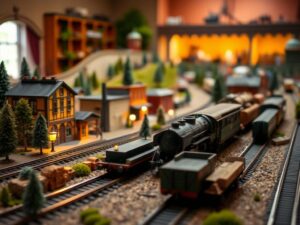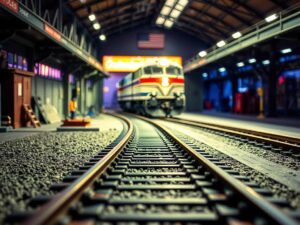How to Run Multiple Trains with DCC on an HO Scale Layout
How to Run Multiple Trains with DCC on an HO Scale Layout
How to Run Multiple Trains with DCC on an HO Scale Layout
Hey there, fellow railroad enthusiasts! Let’s talk about something that brings us all together: the thrill of watching those miniature trains chug along our meticulously crafted layouts. Now imagine the excitement of not having just one train weaving through your scenery, but multiple locomotives, each with its own destination and purpose, working harmoniously on your HO Scale world!
Welcome to the wonderful world of running multiple trains with DCC, or Digital Command Control. This powerful system allows for unprecedented control and flexibility, transforming your model railroading experience from a solo performance into a multi-faceted symphony of rail-borne activity.
What is DCC? And Why Should I Care?
Before we dive into the mechanics, let’s brush up on what DCC is all about. Essentially, DCC replaces the old, basic AC control system with a sophisticated digital one.
Think of it like this: imagine you and your friends are playing instruments in a band. In the old AC world, everyone was just playing along at whatever volume was set for the entire orchestra.
DCC is like having individual microphones and speakers for each instrument â giving every train its own “channel” controlled precisely by you. This allows for incredible control over speed, direction, sounds, and even stopping positions.
Benefits of Running Multiple Trains with DCC:
- Individual Control: Assign different locomotives to separate tasks on your layout â perhaps one freight train hauling cargo across the mainline while a commuter line chugs back and forth to a bustling town station.
-
Realistic Operations: Run trains at varying speeds, even stopping and starting them individually, just like you see in real-life rail yards.
-
Sound Realism: Equip your locomotives with DCC sound decoders for an immersive experience with authentic engine whistles, horn sounds, and more. Imagine that!
-
Smooth Running: DCC eliminates the jerking movements associated with older AC systems, providing smoother operation for all your trains.
Getting Started: The Essential Gear
Now let’s equip ourselves for this digital journey! To run multiple trains on DCC, you’ll need the following:
-
DCC System: Choose a reliable DCC system â there are plenty of reputable brands available like Digitrax, ESU, and Atlas â to form the foundation of your command center.
-
Controller: The “steering wheel” of your operation! Choose a controller that feels comfortable and suits your needs, whether it’s basic throttles or a feature-rich touch screen option.
-
Track Power Supply (Transformer): This is what provides power to your DCC system. Ensure you select one with sufficient wattage to handle all the trains you plan to operate.
-
DCC Sound Decoders (Optional but Highly Recommended!): If realistic sound is your aim, equip your locomotives with DCC decoders. They allow for incredibly detailed sounds and add a whole new level of realism.
The DCC Journey: Programming Your Trains
Programming is key to making the most of DCC!
-
Decoder Basics: Think of each train as having a unique identity. Their decoder receives information from your DCC system, allowing them to move, stop, make noises â you name it!
-
Addressing: Every decoder gets a unique address assigned to it, kind of like a digital phone number, so you can control each locomotive individually.
-
Programming Track (Optional): Some advanced users employ a dedicated programming track. This makes adjustments easier by sending information directly to the decoders during programming sessions.
Setting Up Your Layout: A Blueprint for Success
Before you unleash your DCC system on your layout, it’s crucial to plan ahead. Consider these aspects:
-
Layout Design: Does your track plan naturally encourage multiple train operations? Will different lines cross each other, or is there potential for running loops or yard areas that can accommodate diverse trains?
-
Wiring & Connections: Pay close attention to wiring connections! Keep them clean, organized, and labeled â you don’t want any surprises while operating.
-
Power Routing: Ensure proper power distribution throughout your layout. Use boosters if necessary, especially if your layout spans a significant area, to ensure reliable power delivery.
Mastering the DCC Command: Running Trains Simultaneously
With everything set up and operational, let’s move onto the exciting part! To run multiple trains simultaneously, follow these simple steps:
-
Assign Addresses: Make sure each locomotive has a unique address programmed into its decoder. Avoid overlaps to prevent conflicts.
-
Choose Your Locomotives: Decide which locomotives you want to operate at this moment and give them a command (typically using the throttle control on your DCC controller) to bring them to life.
- Speed Control & Direction: Now you have full command over each locomotive individually. Increase speed, adjust direction â it’s all in your hands!
Beyond the Basics: Advanced Techniques for DCC Experts
Once you’re comfortable running basic trains, there are advanced techniques that can truly elevate your DCC operations. Here are some to explore:
- Programming Macros: Record complex sequences of actions (speed changes, sound effects, stopping positions) and execute them with a single command! Imagine creating realistic yard switching maneuvers or elaborate arrival sequences for your trains!
-
Dynamic Speed Curves & Throttle Mapping: Fine-tune the speed responsiveness of your locomotives with custom curves, allowing you to simulate gradual acceleration and deceleration like real railcars.
-
Auto Reverse Control: This clever feature automatically reverses direction at designated points on your layout â ideal for running continuous loop trains or creating realistic switching patterns.
Your Turn: Join the Multi-Train Adventure!
Running multiple trains with DCC opens a world of possibilities â endless opportunities to create dynamic, captivating, and truly immersive model railroading experiences. Start experimenting, exploring those advanced techniques, and most importantly, have fun building your multi-train symphony of miniature rail travel!
Don’t hesitate to ask questions in the comments below if anything remains unclear or if you have any burning model railroading questions! Let’s learn together and keep this vibrant hobby thriving.




